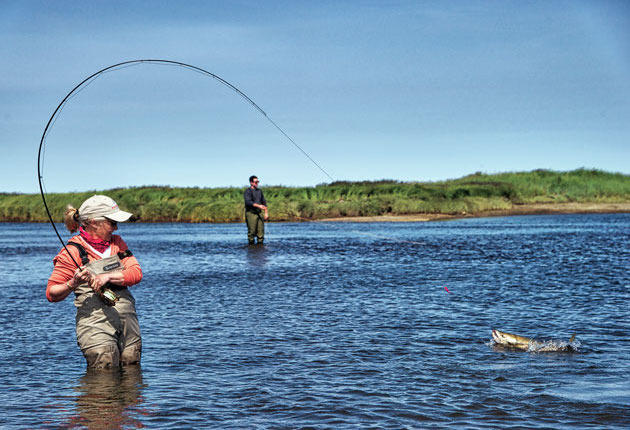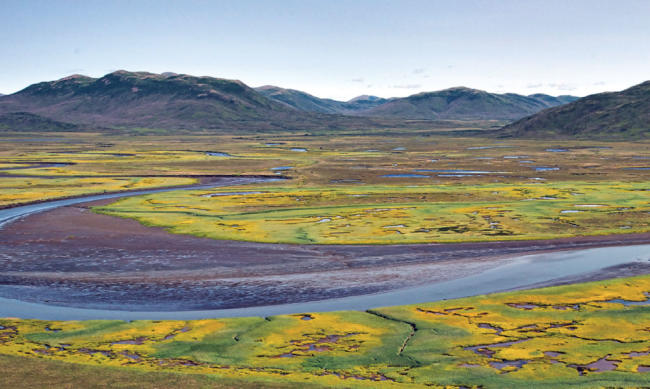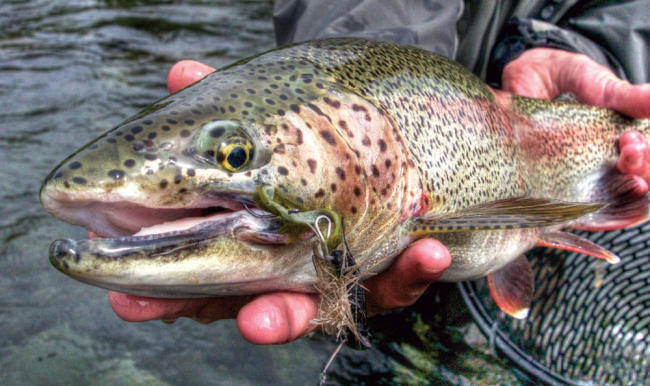One of the First and Still Among the Best
July 23, 2020



 Fishing,SCA Articles
Fishing,SCA Articles

No wonder Lori and I are already talking about Bristol Bay, big rainbows and deer-hair mouse patterns with an eye toward next year.
Martial terms such as fight and battle sound hyperbolic when used to describe the interaction between a fly rod and a trout, but when the fish reach the five-pound range those words become completely appropriate, especially when the trout is an Alaska rainbow with a brisk current behind it. As the backing on my reel came into sight, I realized that I indeed had a fight on my hands, and I was in danger of losing.
But like the loudmouthed drunk at the end of the bar, I’d asked for it. My wife, Lori, and I had spent the two previous days exploring some of Bristol Bay’s remotest water, and there had been plenty of fish: three species of salmon, Dollies, char, and lots of the biggest grayling I’d seen in years. While we’d caught some rainbows in the midst of the previous days’ plenty, there hadn’t been any of the real bruisers for which the area is famous. But Steve Laurent, Bristol Bay Lodge’s owner and manager, knew where to find them, and now, in response to my request, here we were. I couldn’t imagine a place I’d rather be.
Wedged between the Alaska Peninsula and the Bering Sea, Bristol Bay is cold, turbid, and surrounded by unappealing mud flats, but the myriad streams and rivers that run into it from Pilot Point on the Alaska Peninsula north to Togiak Bay are another matter. All five of Alaska’s Pacific salmon species return to these clear waters every year in staggering numbers, and the run of red or sockeye salmon is the largest anywhere.
These drainages contain big oligotrophic lakes, which are low in nutrients and vegetation but cold and highly oxygenated and ideal habitat for sockeye smolt—and the largest rainbow trout in the world. Throw in the other gamefish species mentioned earlier, the world’s highest concentration of brown bears, and some of Alaska’s most spectacular scenery, and superlatives begin to flow as briskly as the current in the streams.
It took the angling community a long time to discover this bounty, largely due to the matter of logistics. In the days before regularly scheduled air service to bush towns such as King Salmon and Dillingham, getting to Bristol Bay meant a major expedition and staying comfortable once you arrived was a challenge. But in the late 1960s a handful of bush pilots and hunting guides began to recognize the recreational potential of the area’s fisheries and tackled the daunting task of building lodges in locations remote, even by Alaska standards.
John and Maggie Gary were among the first to set up shop. Situated on the shore of Lake Aleknagik near the lower end of the famed Wood River–Tikchik Lakes system north of Dillingham, their Bristol Bay Lodge (BBL) opened its doors to angling guests in 1972. She subsequently re-married, and the lodge operation really blossomed under the direction of Maggie and her second husband, Ron McMillian. BBL is one of very few lodges from that era that has run continuously to this day—a tribute to both its prime location and its management.
A trip to BBL begins in Anchorage with a scheduled flight to Dillingham on Alaska Airlines partner Penn Air. From there, lodge staff members drive guests 20 miles to the end of the local road system at the outlet of Lake Aleknagik. Next comes a half-hour boat ride to the lodge through some spectacular scenery. All this sounds complicated, but visitors can leave Anchorage mid-morning and be fishing right after lunch.
Just think what getting there must have been like back in the 1960s.

In Southwest Alaska, salmon from Bristol Bay drive the show, forming the base of the food chain upon which all else depends. Many newcomers to Alaska angling have difficulty grasping the highly seasonal nature of the salmon returns. Being in the right place at the wrong time—perhaps by as little as a week—can mean the difference between spectacular fishing and empty water. Because of BBL’s strategic location and remote fly-out camps, there are always salmon of some kind available from June through September, even though no single week offers prime fishing for all five species. That’s just a matter of biology.
King salmon, the largest, come first, and anglers wishing to target them should visit in June or early July. Silvers, a perpetual fly rod favorite, arrive in August and September, which is later than all others. Pinks, chums, and sockeyes fall in between. All salmon are at their best fresh from saltwater, and Lori and I chose to look for them close to the tideline at the beginning of a recent July visit.
We had flown west for an hour from the lodge to Rainbo Camp, a comfortable remote tent outpost just above the shoreline of Togiak Bay. A short jet-boat ride took us to the confluence of two clear streams where a long gravel bar offered easy wading and plenty of room to cast.
We felt privileged to be fishing with 86-year-old Mike Coe and his grandson, Ted. A professor emeritus in the Yale anthropology department who had done seminal work on cracking the mysterious Mayan code, Mike is one of the few anglers I’ve ever met who has fished more places than I have. He had made more than 20 previous trips to BBL and identified it as his favorite destination of all.
Young, enthusiastic, and capable, Ted already had his fly reel screaming by the time the rest of us finished rigging up. The fish turned out to be a pink salmon, which deteriorate rapidly once they enter fresh water. This one, however, was still bright and fresh from the sea, as were the dozens more we caught over the course of the morning.
Lori’s first strip-set produced an immediate acrobatic leap from a chrome-bright fish that turned out to be a sockeye. This species has little to offer on the end of a fly line once the fish have turned red and prepared to spawn, but pound for pound, bright sockeyes may be the strongest and most acrobatic of all the Pacific salmon. I quickly completed the trifecta by hooking and landing a powerful chum, still carrying sea lice.
Within 30 minutes after our arrival, we saw a young brown bear amble down the opposite bank, studied a rare parasitic jaeger circling overhead, and enjoyed three species of salmon at their best, all taken from the same hundred yards of water. No wonder Mike keeps coming back.

By the time we flew into Birch Camp I was ready for a favorite form of fishing that doesn’t get a lot of playing time in Alaska: drifting dry flies.
We ran up the fabled Goodnews River several miles from camp before we started fishing. Sockeyes dressed in scarlet spawning colors dotted the water, but they hadn’t paired up yet to spawn. With the egg drop still a week or two away I wasn’t sure the rainbows would be there yet, but these waters seldom want for alternatives.
Precisely matching a hatch is seldom an issue in Alaska dry-fly water. Lori started fishing with guide Jared Koenigsfield’s version of the Chernobyl Ant, a black-and-white monster chosen for buoyancy, visibility, and durability rather than resemblance to anything in nature. Her fly failed to complete its first drift before it disappeared in a delicate dimple. As the subtle riseform suggested, the fish turned out to be a grayling. Ten-inch grayling from mountain-headwater streams may be interesting as wilderness icons, but they don’t put up much of a fight. Fortunately, this specimen and the dozens that followed that day were twice that size, richly colored, and sporting dorsal fins that waved hypnotically as the fish came to hand. Grayling have a reputation for eagerly taking dry flies, and catching them can become addictive.
Later, something rose to a skated dry, and I realized at once that it was bigger than any grayling. Dolly Vardens don’t hit dry flies often and they aren’t supposed to jump much, but this one revealed its identity with a leap that would have done credit to any rainbow. The Dollies that day were big—up to 30 inches long—and this one proved a tough fighter for the same reason the salmon had been tough: it had just arrived from saltwater.
While some of the Dollies we caught still carried their silvery bright color from the sea, others had begun to acquire their gorgeous autumn hues. I’ve caught thousands of dollies from Alaska waters over the years, but few have been bigger or more beautiful than those we caught that day—and these came on dry flies, no less.

Lori and I spent the rest of the trip exploring the streams that connect the lakes of the Wood River system for what I will always consider the region’s definitive gamefish: big rainbow trout.
That first morning on the Agulukpak, better known as the Pak by locals and regulars, I did some thinking as I rigged up my rod. When big rainbows enter the streams to gorge on eggs from spawning sockeyes, it can be difficult to catch them on flies that look like anything else. While egg imitations—including beads—can be highly effective, I don’t enjoy fishing with them. Buoyed by our topwater success on the Goodnews, I decided to try my favorite Alaska fishing technique of all: skating mouse imitations across the surface for big rainbows.
Anglers accustomed to fishing with size 18 mayfly imitations may find something disturbingly atavistic about the mere thought of trout dining on mammals. Sometimes the Alaska tundra’s mouse and vole populations explode. When they do, a certain number of the little critters inevitably wind up in the water where big rainbows can’t resist the offer of an easy meal. Watching one attack a mouse imitation on the surface like a musky gulping down a baby duck may not be fly-fishing’s subtlest experience, but it is one of the most exciting.
That morning on the Pak, guide Chris Franzen offered me a full box of furry mouse imitations and let me choose. Mouse fishing is usually an all or none phenomenon—the rainbows are either looking for them or they aren’t. It took me barely a dozen casts that day to prove they were.
One minute Chris’ creation was gurgling across the current like a rodent having a very bad day, and the next it disappeared in a geyser of spray that quickly led to the battlefield position described in the opening paragraph. I eventually landed that fish, a 25-inch rainbow that became the first of many. The mouse hatch must have been in progress, for we even had grayling trying to get their size 14 mouths around mouse imitations bigger than my thumb.
There have been days when I’ve caught bigger Bristol Bay rainbows and days when I’ve caught more. But all those five-pound trout taken on top while acting with the predatory instincts of lions or sharks? Never before, and possibly never again.

I’ve been fishing in Alaska since I first moved there in 1980, and I’ve been fortunate enough to experience a lot of the state’s extensive menu of angling opportunities, from the Southeastern Panhandle to the Alaska Peninsula to the North Slope of the Brooks Range. Even by these eclectic standards the Bristol Bay area is exceptional, and so is the lodge that bears its name.
The week that Lori and I enjoyed there came courtesy of one of those remarkable long-distance friendships that develops in the outdoor writing community.
Minnesota-based painter Bob White is one of the country’s most highly regarded outdoor artists. (I identify the genre ironically, for Bob could obviously paint any subject well.) His work appears regularly in many of our best outdoor magazines including this one, and he has illustrated my back page column in Ducks Unlimited for years. We’d never met in person, however, until I stepped out the door of the Dillingham airport that July.
Despite the incredible amount of time Bob devotes to his art, he has also guided anglers at the Bristol Bay Lodge for years, and Lori and I were there due to his invitation to participate in the lodge’s visionary Artist in Residence program, through which guests and staff mingle with an assortment of artists, photographers, painters and writers over the summer. The honor was almost as exciting as the fish.
Managing a full-service lodge in a remote location is a profound challenge that requires a seamless blend of graciousness and military precision on the part of the staff. Grow too casual and things stop working, from generators to outboards to airplanes. Exert too much discipline, and people stop having fun. The trick is to assemble a staff that knows the bush and the fishing and loves the job. Steve Laurent, himself a longtime veteran of the area, has managed that delicate task as well as any lodge manager I know.
No wonder Lori and I are already talking about Bristol Bay, big rainbows and deer-hair mouse patterns with an eye toward next year.
